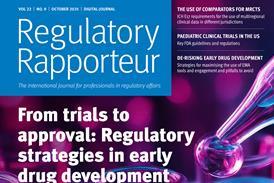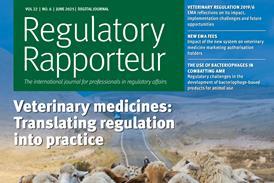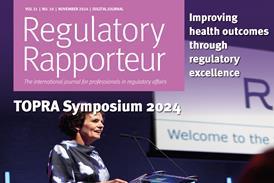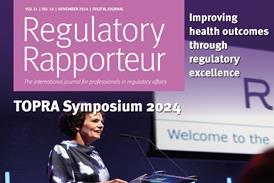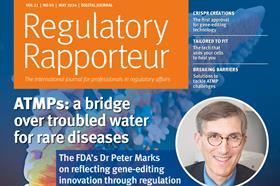
Regulatory Rapporteur
May 2024 | Volume 21 | No.5
Licence notice
Copyright © 2015-2024 The Organisation for Professionals in Regulatory Affairs Ltd. T/A Regulatory Rapporteur − All Rights Reserved. This work is licensed to Dr Jörg Schneider for the purposes of academic and personal reasonable use only.
Notwithstanding this licence, no part of materials published in Regulatory Rapporteur may be reproduced without the express written permission of the publisher.
As a general rule, permission should be sought from the rights holder to reproduce any substantial part of a copyrighted work. This includes any text, illustrations, charts, tables, photographs, or other material from previously published sources.
To obtain permission(s) to re-use content published in Regulatory Rapporteur please email publications@topra.org.
To join TOPRA please click here.

Abstract
Advanced therapy medicinal products (ATMPs) have already played a transformational role in the lives of patients with rare diseases. However, questions do remain with regards to longevity of product effect, repeatability of dosing and manufacturing scalability. An additional challenge is the high upfront cost of ATMPs and how conventional reimbursement schemes affect ability to pay. There is a need to focus on solutions to these challenges, through ongoing studies, new gene therapy platforms, technology advances to support ATMPs manufacturing at scale, as well as alternative drug pricing models. At the end of the day, ATMPs have saved and changed lives. Taking positive steps must remain a priority so that greater numbers of innovative products can reach more patients.
Since the introduction of orphan pharmaceutical legislation which was designed to incentivise innovators to develop medicinal products for rare diseases, there has been a significant increase in the number of advanced therapeutic medicinal products (ATMPs) such as cell and gene therapies. Today, novel ATMPs are well-established for orphan indications and are gradually moving into larger indications.
As this class of therapies continues to mature, challenges are inevitably coming to the fore. And with the expansion of cell and gene therapies into therapeutic categories such as auto immune and metabolic diseases, these issues are set to become increasingly acute.
Exploring ATMPs longevity
While claims of one-and-done ATMPs to potentially cure disease are often made, the duration of therapeutic effect remains uncertain.[1] As researchers have highlighted, repeatability of dosing is important, particularly for diseases that change over time such as in oncology where tumours can evolve to evade destruction by the immune system.[2]
Several factors need to be considered regarding the longevity of ATMPs:
Stability of gene modification
The longevity of gene therapies will often depend on the stability of the introduced genetic modifications. Integrating vectors like lentiviruses into the host genome can provide long-term expression, particularly in long-lived cell types such as stem cells or memory T cells, while non-integrating vectors like adeno-associated virus (AAV) vectors might offer more transient expression.
A study into recombinant AAV (rAAV) vectors found a 50% decline in transgene protein expression from peak expression at 12 to 24 weeks through to 57 weeks.[3] This suggests an associated epigenetic regulation of the transgenes.
Conversely, ongoing and long-term follow-up studies into the CRISPR-Cas9 gene editing technology exagamglogene autotemcel (Casgevy) to treat sickle cell disease show lasting effects. One study found that 28 of the 29 subjects being followed reached the primary endpoint of remaining free from vaso-occlusive crisis for a mean duration of 22.3 months.[4]
Cell persistence
With cell therapies, the longevity of the therapeutic effect often depends on the persistence and functionality of the infused or edited cells. In chimeric antigen receptor (CAR)-T cell therapy for instance, low-level persistence of the modified T cells has been demonstrated. Nonetheless, the length and degree of persistence necessary for a durable response are unclear from the available data and could vary with different CAR constructs and malignancies. Other factors consistently associated with durable long-term remissions are depth of initial response, type of malignancy, receipt of lymphocyte depleting chemotherapy and CAR-T cell levels following infusion.[5]
Immune responses
Key determinants of the efficacy of ATMPs are immune responses to the product. Potentially, the immune system may eliminate cells producing the therapeutic protein, causing loss of therapeutic effect and potentially leading to immunotoxicities.[6] Since viral delivery vectors and allogenic cell therapies can limit the longevity of ATMPs, several strategies are being explored to address immune response and extend therapy longevity. In AAV-based gene therapies for example, the following strategies are either already implemented or explored:
- capsid modifications
- use of alternative AAV serotypes (with low prevalence in human populations)
- pre-existing immunity screening
- transient pharmacological immunosuppression
- plasmapheresis to remove harmful anti-vector antibodies or incorporate immune-evasion genes in the vector [7]
Broader barriers to gene therapy longevity
Over time, the promoters driving the expression of therapeutic genes may be silenced through epigenetic modifications, or transgene silencing, leading to a loss of therapeutic efficacy.[8]
Additionally, vector dilution due to cell division can lead to a decrease in therapeutic gene expression over time, particularly in rapidly dividing cells or growing tissues. Studies have found that gradual decline of vector dilution may impact durability of recombinant AAV gene therapies, with significant variability depending on disease indication, dose, serotypes and the patient.[9]
The ability to re-administer gene therapies is an important aspect for maintaining therapeutic efficacy over time. However, immune responses to the vector can hinder or prevent re-administration…
Therapeutic longevity can also be affected by the initial dose, route of administration and the possibility of dose titration. If the dose is insufficient but cannot be repeated, patients may be left with few other treatment options. One example is sickle cell disease where the clinical threshold is estimated to be at least 20% correction. However, if the dose falls short, the gene therapy would be ineffective through not being able to the repeat treatment.[2]
The ability to re-administer gene therapies is an important aspect for maintaining therapeutic efficacy over time. However, immune responses to the vector can hinder or prevent re-administration.[10]
Addressing longevity challenges
Long-term follow up studies will be key to understanding the longevity of ATMPs. These studies can provide insights into the durability of therapeutic effects and the long-term safety of these therapies. Indeed, as other researchers have noted, these studies are crucial, not only for patients and their caregivers, but also for payers and regulators.[11]
The Food and Drug Administration (FDA) recommends follow-up of up to 15 years for gene therapy in its 2020 guidance.[12] Specifically, the agency recommends a five-year follow-up period for AAV vectors and 15 years for integrating vectors and genome editing products.[13] This is reinforced in new guidance on Human Gene Therapy Products Incorporating Human Genome Editing. Both guidances provide a framework to assess the risk of gene therapy-related delayed adverse events, and introduces gene product characteristics, patient-related factors and recommendations on patient monitoring for licensed gene therapy products.
For its part, the European Medicines Agency (EMA) issued its guidelines on patient follow-up in 2009.[14] The agency’s guidelines take into account the risk profile of a gene therapy based on delivery systems used and in 4.3 of the guideline issues recommendations for each delivery system.
Given the likely ongoing challenges longevity will present, the emphasis should be on developing new gene therapy platforms that are compatible with repeat dosing.[2]
ATMPs at scale – manufacturing challenges
While the ATMPs focus has largely been on rare diseases, there is growing interest in their potential to treat more common conditions. These include metabolic disorders such as obesity and inherited high cholesterol.[15],[16] By way of example, Fractyl Health is developing a local AAV-delivered pancreatic gene therapy expressing glucagon-like peptide 1 receptor agonist (GLP-1RA) for the treatment of both type 2 diabetes and obesity. Both studies are expected to go into phase I clinical trials in 2024.[17]
However, developing ATMPs for these larger disease areas poses challenges for manufacturing scalability, since these require both higher yield and lower cost of goods to make them practicable.[18]
While autologous products such CAR-T therapies that have been successful in treating many relapsed/refractory B-cell and plasma cell malignancies, manufacturing is costly and complex.[19] Even manufacturing of simpler in vivo treatments is multifaceted. Yet, as Peter Marks MD, head of the FDA’s Center for Biologics Evaluation and Research (CBER), has noted, gene therapies could remain inaccessible to patients if these manufacturing challenges cannot be overcome.[20]
Viral vectors such as AAV are a major area of cell and gene therapy research and development, with several approvals by both the FDA and European Commission…
With demand for manufacturing facilities soaring, some attention has turned to point-of-care or decentralised, in-house production methods. Increasingly, academic institutions and biotechnology companies are looking to technology advances to support point-of-care manufacturing and address potential quality challenges.[4] Technologies being trialled to scale up and scale out manufacturing of CAR- and T-cell receptor (TCR)-engineered T cells in the clinic include cell purification, transduction/transfection, expansion and harvest.[21]
(Note: ‘Scale out’ refers to running many smaller units in parallel, and ‘scale up’ means increasing the size of the process).[22]
Scaling in vivo gene therapies
Viral vectors such as AAV are a major area of cell and gene therapy research and development, with several approvals by both the FDA and European Commission.[23] However, large-scale manufacturing of products such as these remains untested. According to a McKinsey report, the priority will be to carefully consider the production system, optimise downstream processing and develop standardised chemistry, manufacturing and control (CMC) methods, and quality assays.[4]
AAV gene therapy is a relatively mature field and in a recent edition of the Cell & Gene Therapy Insights podcast, industry experts reported that there is now wider use of more efficient and scalable manufacturing platforms for these therapies.[24]
Tackling scalability will be key to bringing widespread availability to patients as these therapies being developed move into more prevalent disease categories such as metabolic, autoimmune and neurodegenerative disorders, and the requirement for delivering high doses.

ATMPs and reimbursement in the EU
ATMPs have the long-term potential to save money in health systems by reducing ongoing costs and eliminating the need for life-long treatments. However, their high upfront costs represent a major challenge, as most conventional reimbursement schemes are designed to cover chronic conditions, or in the case of specialist treatments, those that require continuous administration over time.[25]
In addition, these novel therapies can lack the robust, long-term evidence that more established drug classes enjoy.[26]
For its part, the European Federation of Pharmaceutical Industries and Associations (EFPIA) has developed recommendations aimed at increasing patient access to ATMPs while supporting payer decision-making and ensuring a sustainable approach for healthcare systems and patients.[27] Among the key proposals put forward are:
- Using outcomes-based innovative payment models for ATMPs.
- Harmonising evidence requirements across regulators and health technology assessment (HTA) agencies.
- Ensuring an inclusive, multi-stakeholder approach to ATMPs value assessments to include patients and healthcare professionals.
To address ongoing challenges, several alternative drug pricing models have been proposed or implemented in different countries and settings.[28] Two that are most relevant for ATMPs include:
- FINANCIAL-BASED AGREEMENTS: portfolio-based agreements, free initiation or indication-based pricing, payment schedules for one-time therapies with milestone payments.
- OUTCOMES-BASED AGREEMENTS: conditional treatment continuation, coverage with evidence development and outcomes guarantee models – this includes Risk Share Schemes.
Alternative drug pricing models should not be considered to be mutually exclusive and can be combined or adapted to suit different contexts and objectives. However, they also entail some challenges and limitations, such as data availability and quality, measurement and verification of outcomes, administrative complexity and feasibility, as well as stakeholder acceptance and alignment.[29] Therefore, it is recommended to carefully consider design, implementation and evaluation of these models and related key performance indicators (KPI) measures to support their effectiveness and sustainability. It is also advisable to engage early on with payers to discuss these models.
However, the increased use of innovative contracts indicates a generally positive trend in attitudes towards ATMPs from European payers and policymakers.[30] Policy changes or proposals have been seen in several countries, increasing the potential for innovative contracting. In Sweden for example, the Dental and Pharmaceutical Benefit Authority (TLV) in 2023 proposed the application of a higher price level to orphan drugs covered by the Swedish national benefits system.[31] And in the UK, the government is proposing new controls on drug pricing aimed at giving patients access to new medicines while balancing NHS spending.[32] Other countries in Europe have also adopted new pricing policies aimed at supporting the use of innovative therapies.
Streamlining EU decisions
Under the EU’s Health Technology Assessment Regulation (HTAR) adopted in 2021, Joint Clinical Assessments (JCAs) will become mandatory for new technology.[33] One objective of the JCA process is to have a more consistent HTA evaluation across the EU. This would reduce the redundancy of having the same clinical trial submissions for different EU countries as well as seek to address inconsistent patient access and process duplication.
The JCA will come into force from January 2025 for ATMPs and oncology medicines. Engaging in the JCA process, which is anticipated at the time of EMA regulatory dossier filing, offers health technology developers parallel scientific advice from both the regulators and national HTA bodies through a procedure termed Parallel EMA/HTA body (HTAb) Scientific Advice.[34] While pricing and reimbursement are distinct from the JCA process and will remain under full individual member state control, having aligned clinical assessments should allow health technology developers and local authorities to more quickly agree well-informed pricing and reimbursement processes.
Tackling issues of longevity and dosing repeatability of ATMPs will remain a priority for researchers…
Going forward, a priority should be to establish co-creation and collaboration between payers, regulators, and industry to develop agreements that ensure all stakeholder perspectives are considered. It is our recommendation that co-creation begins at the point of initial contact, to consider questions over budgetary impact, clinical value or even long-term outcomes. Furthermore, to identify potential innovative payment schemes, including any infrastructure requirements to address them and to share learnings and best practice.
Conclusion: a patient-first perspective
Tackling issues of longevity and dosing repeatability of ATMPs will remain a priority for researchers and innovator companies. Equally, more will need to be done to tackle manufacturing scalability if innovative ATMPs are to reach more patients and at cost levels that healthcare systems can sustain. However, it’s crucial that we don’t lose sight of the overarching objective: to transform the lives of patients. The experience of the parent of a child with Duchenne muscular dystrophy, who has seen her son’s life transformed by an experimental gene therapy, as well as testimonials from patients who have received Casgevy, were heard during the FDA’s 76th Meeting of the Cellular, Tissue and Gene Therapies Advisory Committee, made this point: it is vital that barriers aren’t put in the way of enabling patients to receive these pioneering treatments.[35],[36]
References
[1] Kohn DB, Chen YY, Spencer MJ. Successes and challenges in clinical gene therapy, Gene Therapy, 30, pages738–746 (2023).
[2] Cell&Gene. Why Repeatability of Dosing Matters for Gene Delivery. Accessed 20 February 2024
[3] Handyside B, Ismail AM, Zhang L, et al. Vector genome loss and epigenetic modifications mediate decline in transgene expression of AAV5 vectors produced in mammalian and insect cells, Molecular Therapy, Dec 2022. Volume 30, Issue 12, 7 December 2022, Pages 3570-3586
[4] FDA (2023) Cellular, Tissue, and Gene Therapies Advisory Committee Meeting, Office of Therapeutic Products.Accessed 20 February 2024.
[5] Cappell KM, Kochenderfer JN. Long-term outcomes following CAR T cell therapy: what we know so far. Nat Rev Clin Oncol. 2023; 20(6): 359–371
[6] Markusic DM, Martin AT, Porada CD, et al. Immunology of Gene and Cell Therapy. Mol Ther. 2020 Mar 4; 28(3): 691–692.
[7] Earley J, Piletska E, Ronzitti G, et al. Evading and overcoming AAV neutralization in gene therapy. Trends in Biotechnology. Volume 41, Issue 6, P836-845, June 2023.
[8] Cabrera A, Edelstein HI, Glykofrydis F, et al. (2022) The sound of silence: Transgene silencing in mammalian cell engineering. Cell Systems 13, December 21
[9] Shen W, Liu S, Ou L. (2022) rAAV immunogenicity, toxicity, and durability in 255 clinical trials: A meta-analysis. Front Immunol. 2022; 13: 1001263.
[10] Gross DA, Tedesco N, Leborgne C, et al. (2022) Overcoming the Challenges Imposed by Humoral Immunity to AAV Vectors to Achieve Safe and Efficient Gene Transfer in Seropositive Patients (2022) Front Immunol. 13: 857276.
[11] Muhuri M, Levy DI, Schulz M, et al. (2022) Durability of transgene expression after rAAV gene therapy, Molecular Therapy. Volume 30, Issue 4, P1364-1380
[12] FDA (2020) Long Term Follow-Up After Administration of Human Gene Therapy Products. Accessed 20 February 2024
[13] FDA (2024) Human gene therapy products incorporating human genome editing: guidance for industry.
[14] EMA (2009) Guideline on follow-up of patients administered with gene therapy medicinal products. Accessed 20 February 2024
[15] Science Daily (2023) Researchers design an innovative strategy to fight obesity through gene therapy. Accessed 19 February 2024
[16] American Heart Association (2023) A single infusion of gene-editing medicine may control inherited high LDL cholesterol. Accessed 19 February 2024.
[17] Fractyl Health. Rejuva gene therapy platform. Accessed 19 February 2024.
[18] Capra E, Gennari A, Loche A et al. Viral-vector therapies at scale: Today’s challenges and future opportunities. Accessed 19 February 2024.
[19] Shah M., Krull A., Odonnell L., et al. (2023) Promises and challenges of a decentralized CAR T-cell manufacturing model. Front. Transplant. Vol 2. Accessed 19 February 2024.
[20] Endpoint News. Homepage. Accessed 19 February 2024
[21] Song H.W., Somerville R.P., Stroncek D.F., et al. Scaling up and scaling out: Advances and challenges in manufacturing engineered T cell therapies. Int. Rev Immunol. 2022;41(6):638-648.
[22] Sargent B. (2018) Scale-Out Biomanufacturing – A Paradigm Change to Scale Up. Cell culture dish. Accessed 21 February 2024.
[23] ResearchGate. List of approved AAV gene therapy drugs. Accessed 19 February 2024.
[24] Cell & Gene Therapy Insights (2023) Can AAV continue to deliver the promise of gene therapy? 2023; 9(9), 1089–1096. Accessed 19 February 2024.
[25] European Commission. (2018) Innovative payment models for high-cost innovative medicines. Accessed 20 February 2024.
[26] ISPOR. The Evaluation of Pivotal Trials for Advanced Therapies From Regulatory and Health Technology Assessment Perspectives in Europe. Accessed 20 February 2024.
[27] EFPIA. (2022) Shifting the paradigm for ATMPs: Adapting reimbursement and value frameworks to improve patient access in Europe. Accessed 20 February 2024.
[28] Dabbous M, Chachoua L, Caban A, et al. Managed Entry Agreements: Policy Analysis From the European Perspective. Value in Health. Volume 23, Issue 4, April 2020, Pages 425-433
[29] Thanimalai S, Chon WY, Kwing-Chin Lee K. Stakeholder views of managed entry agreements: A literature review of national studies. Health Policy Open. 2021 Dec; 2: 100032.
[30] Deloitte (2019) Patient access to innovative medicines in Europe. Accessed 20 February 2024.
[31] Kleja M (2023) Swedish authority proposes new pricing model for orphan and ordinary drugs. Euractive. Accessed 20 February 2024.
[32] GOV.UK. (2023) Proposed update to the 2023 statutory scheme to control the costs of branded health service medicines. Accessed 20 February 2024.
[33] Amerisourcebergen.com. Multistakeholder perspectives on Joint Clinical Assessment in Europe. Accessed 22 February 2024.
[34] AmerisourceBergen (2023) Q&A – Preparing for the EU Joint Clinical Assessment (JCA) process. Accessed 21 February 2024.
[35] FDA. The 76th Meeting of the Cellular, Tissue, and Gene Therapies Advisory Committee, FDA. Accessed 22 February.
[36] The New York Times. The Future of Medicine Is Unfolding Before Us. Are We Nurturing It? Accessed 21 February 2024.




